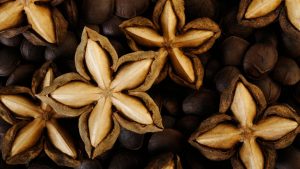Sacha Inchi, sacha peanut, mountain peanut, Inca nut or Inca-peanut comes from the seeds of the plant Plukenetia Volubilis. The roasted seeds can be consumed as nuts and the roasted leaves chewed or transformed into tea.
Sacha Inchi oil is characterized by a sweet flavor with a nutty finish.
The latter belongs to the Euphorbiaceae family . It is a climbing plant native to the Amazon forest, and is unique to this region of the world which covers parts of Brazil, Peru, Colombia and Ecuador.

The Sacha Inchi plant is recognized by its fruits, which are very characteristic, in the shape of a star. In phytotherapy, and in the making of Sacha Inchi oil , it is the seeds of the fruit that are used. A fatty oil is extracted from it and it is very famous for its benefits on the health and in cosmetics.
Sacha Inchi oil is a very popular form, we can also consume roasted seeds or flour (or protein powder) from this small fruit. o ffering you the possibility to prepare as marinades, salted, or other Phat Thai. I t will replace cashews, peanuts and pistachios . Don’t hesitate to spice it up to serve it!
At the age of two, it is often possible to harvest up to a hundred dried fruits at a time, resulting in 400 to 500 seeds several times a year. The fruit capsules usually consist of four to five lobes, but some may have as many as seven.
The Sacha Inchi oil will be very useful to stimulate the immune system, to protect the cardiovascular system, and to maintain a normal cholesterol level (we will come back to this).
If you want to know more, don’t hesitate to consult our pages on the benefits of omega 3 on health and the importance of the balance between omega 6 and omega 3.
In this context, some other vegetable oils are suitable, including those richest in omega 3 (flax, hemp, chia ). The high concentration of omega 3 of this vegetable oil is worth some other benefits.
Indeed, it is mentioned in the context of insulin resistance, which is increased for people suffering from type 2 diabetes. The omega 3 contributes to the reduction of triglycerides, generally elevated in diabetic people. Adding Sacha Inchi to a breakfast rich in saturated fats helps improve insulin resistance for people with diabetes and prevents cardiovascular risks.
The first explorers of South America testify that its taste resembles that of almonds , it is delicious grilled!
How are sacha inchi seeds used?

This is how the seeds are used. The richness of this nut is surprising: a true concentration of oil and proteins, it presents a very good balance of fatty acids, and a perfect assimilation. The seed of Sacha Inchi is very rich in vitamin A and vitamin E .
The plants flower in five months, and the seeds are formed from eight months. Once an Inca nut plant starts producing seeds, it can do so almost all year round. A plantation in China has reached its highest level of fruit production in the second or third year. To avoid handling the messy pulp of ripe fruit, let it dry on the plant before harvesting. The messy black pulp will dry out.
Raw seeds should be roasted before eating; otherwise they are too bitter. They should be roasted at a low temperature (below 60 ° C [140 ° F]) to preserve the heat-sensitive omega fatty acids. On the other hand, the oil is extracted from the raw, unheated seeds. The seeds are “cold pressed” to avoid damaging (by oxidation) the omega fatty acids that the oil contains. One source mentioned that if not used quickly or stored in the refrigerator, the oil goes rancid.
In comparison to other oilseeds, Sacha Inchi oil contains:
- 48% of omega 3 (against 0.6% for the pistachios, 0.4% for the cashew nuts)
- 36% of omega 6 (against 68,9% for the sunflower seeds, 33,2% for the peanuts, 31% for the pistachios, 17,3% for the cashew nuts)
- 24.7% protein (compared to 25.8% for peanuts, 20.8% for sunflower seeds, 18.3% for flax seeds, 17.3% for sesame seeds).
Mode of consumption:
- As an appetizer, replacing peanuts and cashews. Without allergens and with a higher essential fatty acid content, it will satisfy all your cravings!
- Once crushed, in breading for your appetizers (shrimps)
- With chicken or any other poultry, as a replacement for peanuts, in a curry or for brochettes. It goes very well with coconut milk!
- With other meats, in a caramel pork or a beef with sacha inchi and plantains
With vegetables, to add crunch to your raw vegetable salads, in your cakes and quiches, or to spice up a soup with its sharp flavor!
Rich in 8 amino acids, Sacha Inchi is an important protein for the body since it is not able to create it. This seed is great – 30% protein by weight – more than many nuts and seeds. Protein is an important element for the body. It also plays a role in the creation of enzymes, hormones and other biological chemicals.
Have you ever heard of Sacha Inchi oil before?
Share with us your experience using this essential oil .
